
We walk along the road from the Hill takes us to some caves, the caves of pertucce.
We decided to go out on a bike, it's a nice day, the scent of wild mint and intoxicates us daisies and a slight breeze of wind refreshes the skin and face.
You hear that noise?
It's a ping, lilting, almost a dance ... sometimes we feel it, sometimes not.
After a few meters above a bend and we arrive at the entrance of the caves, a bare, almost anonymous.
We hold the bike and overcome the stone Archway by way of door.
We close our eyes and noise manifests itself again, stronger, more determined.
As in a whirlwind of rumors, noises, images, feelings we have to open our eyes and see that ... we went back to 2700 years. What kind of sorcery is this?!
Will the mysterious atmosphere, will our love of history and Etruscan culture but we find ourselves in the midst of 700 b.c. surrounded by real Etruscans!
We explore this cave and we understand better the life and culture of the Etruscans.
WE WEAR THE TEBENNO AND DISCOVER THE CAVE
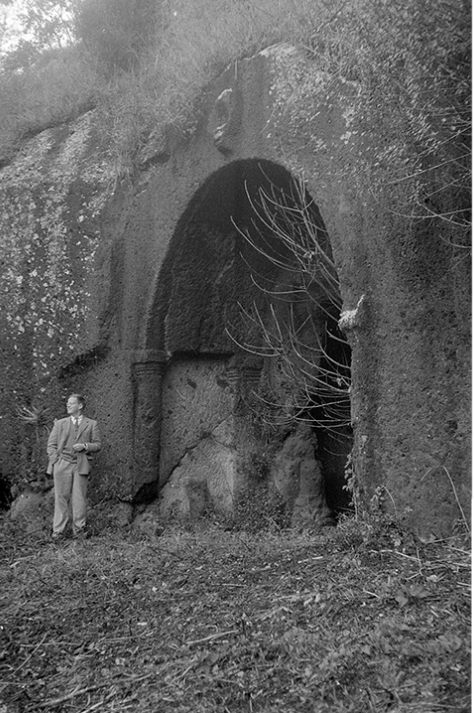 The first thing we can figure out is that this cave was first used as the simple quarry, a kind of stock, but which was later transformed by its owners in housing.
The first thing we can figure out is that this cave was first used as the simple quarry, a kind of stock, but which was later transformed by its owners in housing.
There are many tunnels, some large, some very small, maybe used to get animals and bring them in their stables to rest.
This was no doubt a simple habitation, inhabited possibly by farmers or ranchers who had used some of the rooms of the House to the stables to the animal shelter.
But the houses of the Etruscans were not all like that.
The Etruscans was indeed rich and refined, with a culture and attention to detail is important.
The houses were generally rectangular, divided into several rooms by bearing walls that rested on dry foundations in Tuff, limestone or marl depending on local availability. The floors were usually timber-framed walls and clay or brick, with wooden beams and pillars. The roofs, which are in turn supported by wooden beams, were covered in terracotta tiles; Alternatively was practiced the technique of rammed earthby clay inside formwork; these walls were stronger and they could be without adding load-bearing beams and pillars. (source: Wikipedia, the free encyclopedia).
Naturalmente le famiglie più ricche potevano permettersi case più grandi e gli aristocratici si facevano costruire veri e propri palazzi che si componevano di molti ambienti, fastosamente arredati.
Le pareti esterne erano ravvivate con vivaci colori applicati direttamente sulle pareti oppure con ri-vestimenti di terracotta con scene dipinte. Sui tetti venivano collocate figure di terracotta e gocciolatoi a testa animale. (fonte: http://www.archeologiatoscana.it/download/64/101_abitazioni_e_vita_quotidiana.pdf)
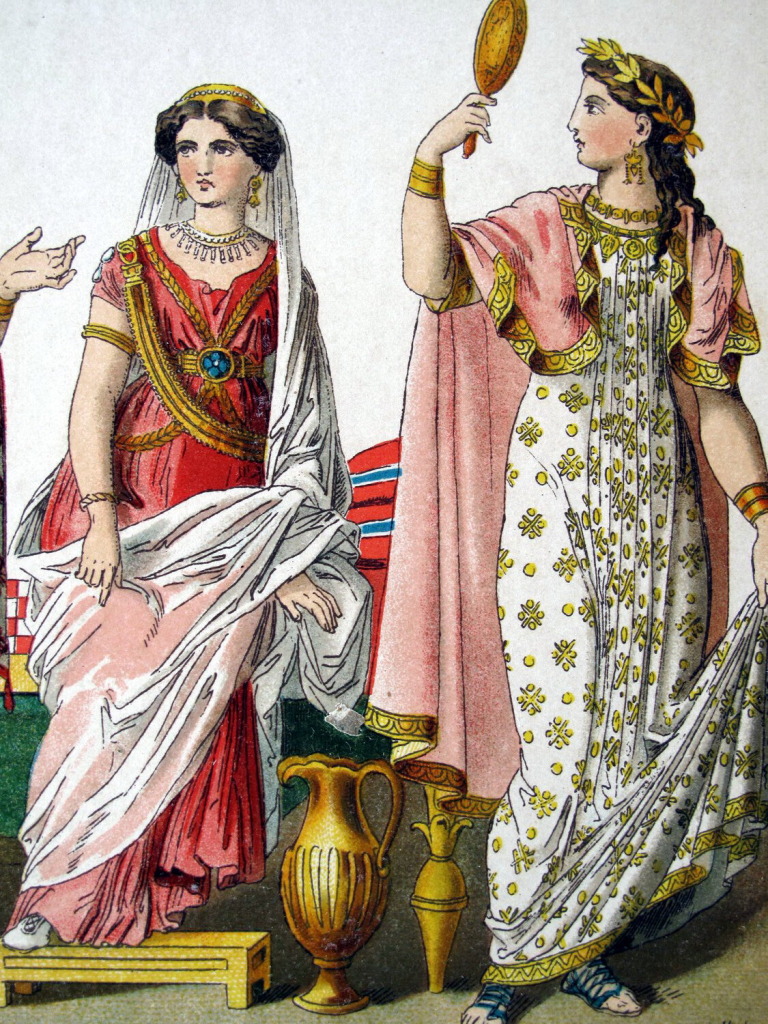 Ora sono sicuro che vi starete chiedendo, ok, siamo entrati, ci hai raccontato com’è fatta una casa Etrusca, ma si può sapere cosa diavolo sia il tebenno?!
Ora sono sicuro che vi starete chiedendo, ok, siamo entrati, ci hai raccontato com’è fatta una casa Etrusca, ma si può sapere cosa diavolo sia il tebenno?!
🙂 Avete ragione, ve lo spiego subito.
The Tebenno was the most important Etruscan garment, a simple cloak, but so important that it could be worn as a garment unique. Could be dressed in different ways: transversely from one shoulder and under the opposite arm (a bit like wore the tunic the Romans) or by way of shawl or otherwise. Not infrequently was lined with cloth of various colors.
Women wore a light tunic, linen probably rich in ornaments and finely decorated, leading down to the feet.
Sopra la tunica le donne Etrusche indossavano un mantello più pesante e amavano adornarsi con onili di varia fattura e gioielli vari: e non si trattava di semplici ornamenti, a volte indossavano gioielli assolutamente fastosi e riccamente decorati, degni di regine e re.
La cosa più curiosa dell’abbigliamento Etrusco era senza dubbio il berretto e le scarpe a punta che indossavano i bambini 🙂
Toh, eccolo lì, me ne è appena passato uno davanti… ma dove va cosi tutto di corsa?
ENTRIAMO IN CUCINA! CIBO E ALIMENTAZIONE ETRUSCA
Quel monello corre come uno scatenato e facciamo sinceramente fatica a stargli dietro.
Superiamo un ostacolo, entriamo in un cunicolo ed eccoci arrivati in cucina.
The smells they capture our attention as well as the cooks who are scrambling to prepare dinner.
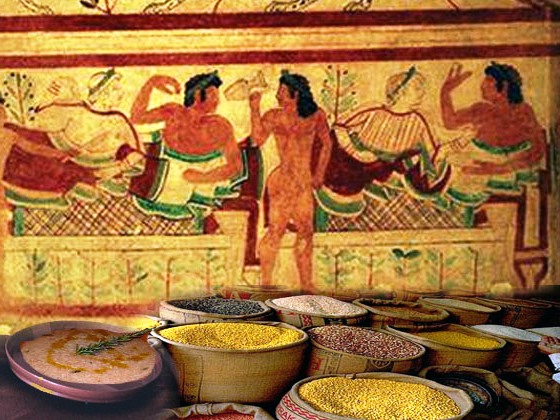 We are incurioriositi, we take a closer look.
We are incurioriositi, we take a closer look.
The Etruscans cooked mainly outdoors and were well aware of the different ways of cooking.
The Etruscans are considered a people pleasurable, though until the 6th century BC the food was eaten standing up, usually in solitude. Only later, when lunch became a moment of power management, we feasted on lying on couches, with the manner of the Greeks. And in this, the Etruscan is differentiated from other peoples because banquets were women allowed.
The main foods were derived from pigs, sheep, poultry and game and definitely legumes and fruit. Seeds have been found in excavations of Etruscan settlements of hazels, acorns, olive, fig, barley, plum and even remnants of beans.
 Their kitchen was definitely based on garlic that grew naturally in the shady areas and healing foods deemed by them, onion, aphrodisiacs and stimulating. The onion was so moderate by the nobles exclusively crush instead of servitude which made excessive use and raw seasoned with a little salt.
Their kitchen was definitely based on garlic that grew naturally in the shady areas and healing foods deemed by them, onion, aphrodisiacs and stimulating. The onion was so moderate by the nobles exclusively crush instead of servitude which made excessive use and raw seasoned with a little salt.
And that is precisely what is eating garlic baby, there he is, beside a buxom woman, I think it's the mom.
But why a child should eat garlic will you say?
The Etruscans, as well as other nations of antiquity, made great use of plants and herbs for their medicine, garlic for example was used as purifying and as medicine against intestinal parasites.
Who knows what that naughty boy has eaten something they've done wrong.
Still have that twang, but where does it come from?
Following the rhythmic melody and mesmerizing within in a small tunnel until you come to a large room that overlooks a forest and here I see a great show, the famous ritual of Lusus Troiae, play of Troy.
WARRIORS AND DANCERS
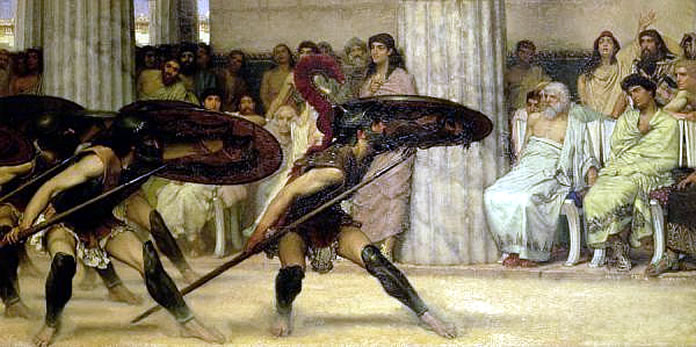 The ceremony of Lusus Troiae (ludo Troiano), born in Etruria, was a ludo involving Knights as a cultural Mysterium, only the initiated and took place on the occasion of undertakers and the founding of the city and subsequently, in days of Atonement, celebrated annually on fixed dates.
The ceremony of Lusus Troiae (ludo Troiano), born in Etruria, was a ludo involving Knights as a cultural Mysterium, only the initiated and took place on the occasion of undertakers and the founding of the city and subsequently, in days of Atonement, celebrated annually on fixed dates.
The symbolic ritual battle and labyrinthine path on the occasion of the funeral is certainly manifold. The labyrinthine path expresses the distance separating the sphere of life and death and the difficulty of the passage from one to the other.
Here, in this place, you're celebrating the death of a woman or a man of importance and are perceived by many city-States.
In the distance I see a craftsman intent on painting a beautiful vase, the famous Oinochoe of Tragliatella.
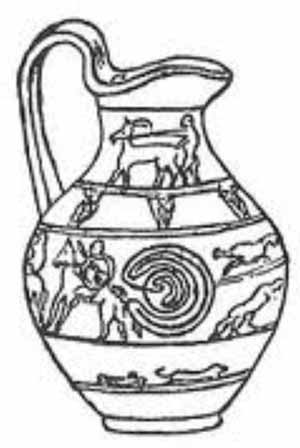 The oinochoe is a vessel similar to the jug, used to pour the wine or water. Used in prellenica, there are specimens in both metal and terracotta in the great variety of forms that this vessel across the geometric and orientalizing took to arrive at attic black-figure and Red-figure completed.
The oinochoe is a vessel similar to the jug, used to pour the wine or water. Used in prellenica, there are specimens in both metal and terracotta in the great variety of forms that this vessel across the geometric and orientalizing took to arrive at attic black-figure and Red-figure completed.
The oinochoe is characterized by an elongated oval body, more or less, with only, and has a height ranging from 20 to 40 cm.
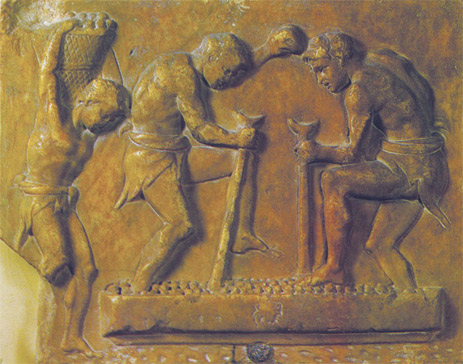 The vase is beautiful and is certainly more than just a story or description of an initiatory dance, I think the more precise explanation and give concrete Prof.ssa Alberti in his song,
The vase is beautiful and is certainly more than just a story or description of an initiatory dance, I think the more precise explanation and give concrete Prof.ssa Alberti in his song,
“Sand the most accepted interpretation sees overall figurative reference to the adventure of Theseus's apparent lack of theme of wrestling with Minotaur and dance of the hostages freed as they are in the François vase, but we can assume that those reasons have been replaced by the representation of the labyrinthine army dance of lusus Troiae practiced in Etruria in the seventh century. BC Lusus Troiae in the theme we can identify three symbolic aspects:
a) protecting deceased's stillness;
b) protection of the living by the deceased;
c) an indication of the way that the soul of the deceased must drive in the underworld.
A maze is also represented on the threshold of the Temple of Cuma where believed to be the entrance of Hades.
We can therefore say that the jug, placed in a tomb, would be through its friezes the space theme of eternal return within the sequence the life, death, rebirth, an exemplary model of the initiatory pattern of inner transformation, itself closely linked to the reason of ritual sacrifice which autoesplicazione the development of individual parts and at the same time commitment in favor of an upper unit transcendent that even the includes. " (The frieze of noodle oinochoe curated by m. Rita Albanians, in «átopon» 1992 vol. S)).
It's pure magic that I'm experiencing ... but hold on, what's happening?!
As I find myself getting sucked into a space-time vortex in having to close my eyes to cusa a stellar dust that blinds me, only after several seconds I can reopen it.
Ed eccomi tornato nel ventunesimo secolo, nel silenzio di questa antichissima dimora ormai spogliata della sua vita dal tempo e dall’incuria dell’uomo. Ma pur sempre meravigliosa e capace di raccontare storie che si perdono negli abissi del tempo.
Visitatela con il corpo, la mente e l’immaginazione, ne vale la pena! 😉

Foto di Alessandro Capecchi
